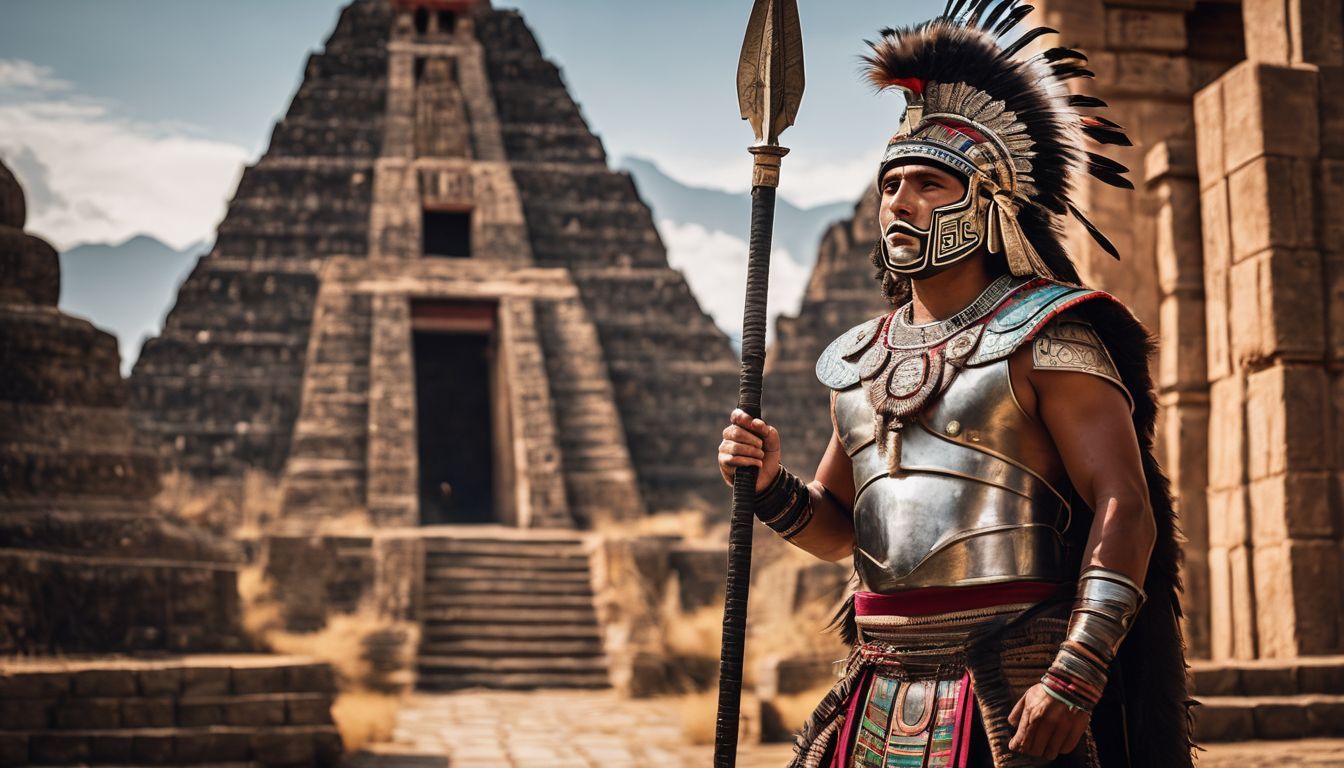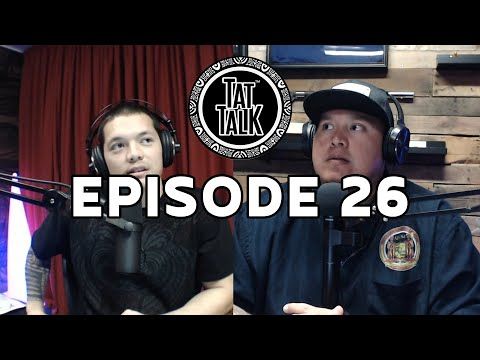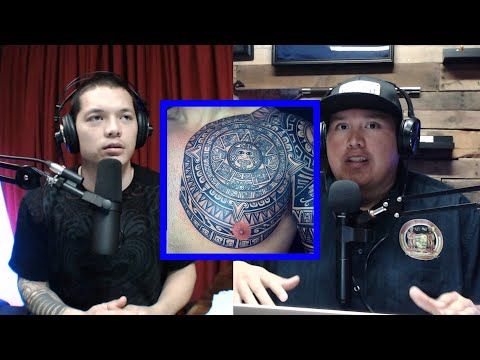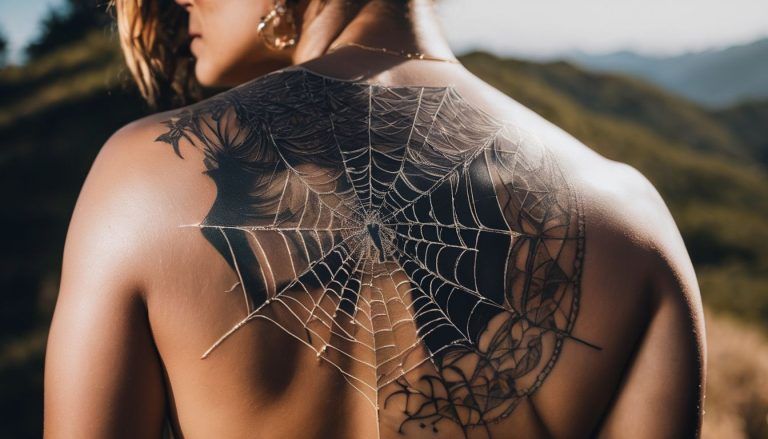Exploring the Rich Symbolism of Aztec Tattoo Designs
Deciding on a tattoo design can leave you scratching your head. Aztec tattoos are more than just ink; they carry stories of heritage and bravery. Our journey through Aztec symbols will show you how to choose art that echoes your spirit.
Discover their ancient power today!
Key Takeaways
- Aztec tattoos are rich with cultural and historical significance, often featuring symbols of warfare, spirituality, and nature from the ancient Aztec civilization that thrived between the 14th and 16th centuries.
- Popular designs include depictions of revered Aztec deities like Quetzalcoatl and Tláloc, as well as traditional patterns such as the feathered serpent, which symbolize wisdom and balance.
- The choice of animal motifs in Aztec tattoo designs, such as jaguars for strength or eagles for energy and bravery, adds to their deep symbolic meanings.
- Placement of these tattoos varies according to personal preference with options ranging from large back pieces to small minimalist designs on wrists or ankles.
- Personalizing an Aztec tattoo design by incorporating individual stories or significant elements can create a unique piece that honors one’s heritage while expressing personal identity.
Understanding the Aztec Culture and Tattoo Traditions
The Aztecs were a Mesoamerican civilization known for their intricate tattoo traditions, which held deep cultural and spiritual significance. These tattoos often featured symbols of warfare, spirituality, and the natural world, reflecting the rich symbolism of Aztec art and culture.
Who were the Aztecs?
Hailing from central Mexico, the Aztecs were a Mesoamerican civilization known for their powerful empire and profound cultural influence. Flourishing between the 14th and 16th centuries, they built monumental cities such as Tenochtitlan—now Mexico City—centered around their warrior-centric society and polytheistic religion.
These indigenous people left behind a legacy of sophisticated astronomical studies, architectural marvels, and rich mythological tales.
Their mastery in various forms of art extended to tattooing, which was an integral part of Aztec culture. Warriors inked symbols representing valor and achievements while citizens depicted devotion to gods through ritualistic body art.
Now let’s delve into the significance of tattooing within this ancient civilization.
The significance of tattooing in Aztec culture
Tattooing in Aztec culture held immense cultural and historical significance, symbolizing rituals, beliefs, and personal stories. Each tattoo told a unique story and conveyed the individual’s lineage, achievements, and devotion to the gods.
The use of motifs in Aztec designs was distinct from other tribal designs, making them easily recognizable, with symbols like Huitzilopochtli representing valor, guidance, and protection.
Additionally, Aztec eagle tattoos symbolized strength and bravery linked to warriors and nobility. Furthermore, Aztec tattoo designs were often associated with themes of femininity, strength,.
Styles and symbolism of Aztec tattoos
Aztec tattoo designs feature intricate geometric patterns and symbols deeply rooted in Mesoamerican culture. The use of sacred geometry, traditional motifs, and mythological imagery makes these tattoos highly symbolic and visually striking.
Symbols like the feathered serpent, representing Quetzalcoatl, showcase ancient Aztec beliefs and deities, adding layers of cultural significance to the design. Additionally, tribal elements such as Huitzilopochtli or the eagle convey qualities of valor, strength, and nobility within the Aztec tradition.
These symbolic representations make Aztec tattoos a captivating choice for individuals seeking to honor their heritage through body art while embracing the rich cultural meanings embedded in these ancient designs.
Choosing the Right Body Placement for Aztec Tattoos
Popular body locations for Aztec tattoos include the upper arm, back, and chest. Minimalistic designs can also be chosen for subtle placement on areas like the wrist or ankle.
Popular locations for Aztec tattoos
Aztec tattoos are often placed on the back, arms, chest, and legs.
- The back is a popular location for larger designs, allowing for elaborate depictions of Aztec deities or intricate patterns to be showcased.
- Arms offer a versatile canvas for Aztec tattoo designs, with options like bands or sleeves incorporating traditional motifs and symbols.
- Chest tattoos are chosen to symbolize strength and protection, often utilizing powerful Aztec symbols such as the eagle or warrior imagery.
- Leg tattoos provide ample space for detailed designs that can weave storytelling elements and cultural significance into the artwork.
Minimalistic designs for subtle placement
When considering a minimalistic approach to Aztec tattoo designs, one may opt for subtle placements that carry deep cultural significance while maintaining a discreet aesthetic. Here are some ideas to achieve this:
- Utilize small and delicate Aztec symbols or patterns to adorn areas such as the wrist, ankle, or behind the ear. This allows for personal expression without overwhelming the visual landscape of the body.
- Incorporate fine lines and intricate detailing to create understated yet elegant pieces that highlight the beauty of Mesoamerican motifs in a subtle manner.
- Explore geometric shapes and minimalist compositions inspired by traditional Aztec art, offering a modern interpretation of ancient symbolism in a refined fashion.
- Consider single – element designs, such as a simple yet powerful depiction of an Aztec deity or sacred animal, to convey meaning in a restrained and sophisticated manner.
- Embrace negative space within the design to achieve a minimalist look while still capturing the essence of Aztec symbolism and cultural heritage.
Exploring Popular Aztec Tattoo Designs
Discover the deep cultural and symbolic meanings behind popular Aztec tattoo designs, including depictions of revered deities such as Quetzalcoatl and Tláloc, traditional patterns like the feathered serpent, and representations of animals in Aztec art.
Explore the rich history and visual storytelling woven into these ancient Mesoamerican tattoos.
Depictions of Aztec deities such as Quetzalcoatl and Tláloc
Aztec tattoo designs often feature depictions of powerful deities from their rich mythology, each with its own symbolic significance. These deities are revered for their unique qualities and hold a special place in Aztec culture. Here are some notable depictions of Aztec deities in tattoo art:
- Quetzalcoatl, the feathered serpent, symbolizes wisdom, creativity, and the cycle of life and death. Its prominent role in Aztec mythology makes it a popular choice for those seeking tattoos that represent transformation and rebirth.
- Tláloc, the rain god, is often depicted with fangs and goggle eyes, embodying the forces of nature and fertility. Tattoos featuring Tláloc symbolize life-giving rain and agricultural abundance, reflecting a connection to the earth and natural cycles.
- Huitzilopochtli, the sun god and patron deity of the Aztecs, represents war, power, and vitality. His association with warfare and sacrifice makes him a compelling figure for those seeking tattoos that convey strength and resilience.
- Xipe Totec, the god of agriculture and renewal, is often depicted wearing flayed human skin as a symbol of rebirth through sacrifice. Those who choose Xipe Totec tattoos may seek to honor themes of growth, transformation, and spiritual evolution.
- Coatlicue, the earth goddess and mother of gods, embodies fertility, creation, and destruction. Tattoos featuring Coatlicue often signify the nurturing aspects of femininity as well as the transformative powers of nature.
- Tezcatlipoca, the smoking mirror god associated with sorcery and divine intervention. Tattoos representing Tezcatlipoca reflect themes of mystery, introspection, destiny shaping.
- Mixcoatl is an ancestral deity linked to hunting and stars; his tattoos capture themes related to guidance spiritualityprowess in hunting.
- Tonatiuh was worshipped by warriors as he represented solar energy; his tattoos capture themes related to powerpersonal strength.
Traditional patterns and symbols like the feathered serpent
Aztec tattoo designs often feature traditional patterns and symbols that hold deep cultural significance. The feathered serpent, known as Quetzalcoatl, is a prominent symbol in Aztec art and mythology. It represents wisdom, creativity, and the duality of human nature. Incorporating this powerful symbol into an Aztec tattoo design can add layers of meaning and symbolism to the artwork.
- Quetzalcoatl, or the feathered serpent, is a central deity in Aztec mythology, revered for its association with creation and renewal.
- In Aztec culture, the feathered serpent is symbolic of knowledge, learning, and the harmonious balance between opposites.
- Featuring Quetzalcoatl in an Aztec tattoo design signifies intellect, guidance, and the connection between earth and sky.
- The intertwining feathers and serpent imagery represent the duality of life – the spiritual and earthly realms coming together in harmony.
- Incorporating Quetzalcoatl into an Aztec tattoo serves as a tribute to ancient wisdom and the interconnectedness of all living things.
- The symbolism behind the feathered serpent adds depth to an Aztec tattoo design, reflecting themes of transcendence and enlightenment.
Representations of animals in Aztec art
- Traditional patterns and symbols like the feathered serpent hold significant meaning in Aztec tattoo designs, but animals also feature prominently in this ancient art form.
- The jaguar, a symbol of power and strength, is often depicted in Aztec tattoos to represent the warrior spirit and courage.
- Eagles are revered in Aztec culture and appear in tattoo designs as symbols of cosmic energy, fertility, and bravery.
- Coyotes, known for their cunning nature, are featured in Aztec art as representations of intelligence and resourcefulness.
- Serpents are common motifs in Aztec tattoos, symbolizing transformation, renewal, and healing.
- Dogs were often associated with the afterlife in Aztec beliefs and are depicted in tattoo designs as protectors and guides for the soul.
- The hummingbird plays an essential role in Aztec mythology and symbolizes agility, joy, and vitality – making it a popular choice for tattoo designs.
Customizing Aztec Tattoo Designs
Adding personalized elements to traditional Aztec designs can make your tattoo unique and meaningful, working with a skilled artist will help bring your vision to life. Ready to create a one-of-a-kind piece that reflects your individuality and appreciation for ancient cultures? Keep reading to learn more about customizing Aztec tattoo designs!
Incorporating personalized elements to traditional designs
Aztec tattoo designs offer a meaningful way to personalize traditional symbols and motifs, allowing individuals to infuse their own stories and experiences into the artwork. Here are some ways you can incorporate personalized elements into Aztec tattoo designs:
- Infusing ancestral lineage or personal achievements into traditional Aztec symbols adds depth and meaning to the design, honoring cultural heritage while celebrating individual milestones.
- Incorporating significant dates or numerals within the tattoo design can represent important events or anniversaries in one’s life, blending personal history with ancient symbolism.
- Adding subtle elements that reflect specific experiences or beliefs, such as incorporating nature-inspired imagery or personal emblems, creates a unique fusion of individual expression and traditional symbolism.
- Collaborating with a skilled tattoo artist who understands the intricacies of Aztec art allows for the customization of traditional designs to reflect personal narratives and values.
- Intertwining meaningful words or phrases in Nahuatl (the Aztec language) within the design can encapsulate powerful messages or mantras that hold personal significance.
- Adapting traditional symbols to represent modern interpretations of timeless concepts, such as love, resilience, or spiritual growth, offers a contemporary twist on ancient motifs.
- Incorporating elements from other cultural influences that hold personal significance alongside Aztec symbols can create a tapestry of diverse meanings within the tattoo design.
- Enhancing traditional designs with personalized color palettes or stylistic details allows for a seamless integration of individual preferences while upholding the essence of Aztec symbolism.
Working with a tattoo artist to create a unique Aztec-inspired piece
After incorporating personalized elements to traditional designs, collaborating with a skilled tattoo artist can bring your Aztec-inspired piece to life. When working with a tattoo artist, it’s crucial to communicate the symbolism and personal significance you want the design to convey.
Utilize keywords such as “ancient civilizations,” “Mesoamerican symbolism,” and “tribal tattoo designs” when discussing your vision for the unique piece.
Consider sharing important facts like how Aztec tattoos are deeply rooted in historical significance and cultural symbolism. Emphasize that these details will help guide the creation of an authentic Aztec-inspired design that reflects your individual story or heritage.
Conclusion and Final Thoughts on Aztec Tattoo Symbolism
Aztec tattoo designs hold deep symbolism, representing lineage, achievements, and devotion to the gods. Each design narrates a unique story while carrying cultural and historical significance.
The motifs in Aztec tattoos are distinct, making them easily recognizable and valued for their rich history. Incorporating personalized elements into traditional designs allows for the creation of unique Aztec-inspired pieces.
Working with a tattoo artist can help capture the essence of Mesoamerican symbolism in contemporary body art.
FAQs
1. What do Aztec tattoo designs represent?
Aztec tattoo designs showcase the rich history and symbolism of an ancient civilization, featuring indigenous artwork and symbols from Mesoamerican culture.
2. Are Aztec tattoos just about looks or is there more to them?
There’s much more! Aztec tattoos are deeply rooted in the symbolism and traditions of tribal tattoo designs from ancient civilizations, often telling stories or representing historical body art.
3. Can anyone get an Aztec tattoo?
Yes, anyone can choose to have an Aztec tattoo but understanding the traditional body art and respecting its cultural significance is important.
4. Why should I consider getting an Aztec design for my next tattoo?
If you appreciate meaningful ink, exploring the rich symbolism of these traditional tattoos connects you with a powerful lineage derived from indigenous artwork and ancient symbols.










